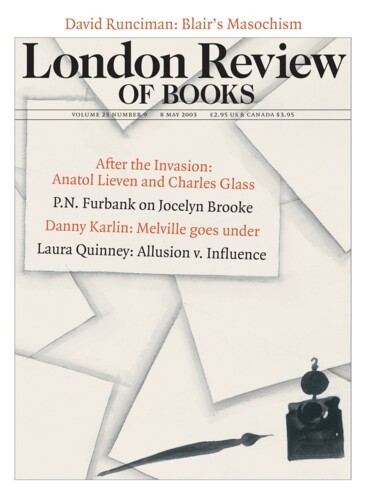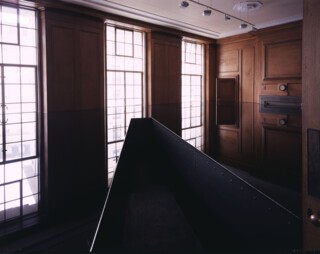The Saatchi Gallery, now to be found in the old County Hall building, spreads itself down long corridors and through ranks of offices. Many of these contain single works. Only in the big rotunda are a substantial number of pieces seen together – among them Damien Hirst’s very large anatomical model and Ron Mueck’s very small sculpture Dead Dad.
Anyone will be disappointed by the Saatchi collection who was waiting for art which would take strength from County Hall’s Edwardian architecture. The look of the building prompts ironic comparisons between the art it implies – portraits of civic dignitaries, perhaps, or a Frank Brangwyn allegory of merchant adventurers – and the newer art on display: art which first teases you or insists on having your attention, and is then often vague or crass about what to do with it. Only one piece, Richard Wilson’s 20:50, a room-sized tank of sump oil, borrows much force from the building. It is even more effective here, reflecting wood panelling, windows and the sky beyond, than it was in the collection’s former gallery in St John’s Wood, where it reflected a glass roof. You walk into it down a narrowing, steel-walled, waist-high passage, where black oil rises to the rim and stretches out all around you. The tank is neatly tailored to follow the room’s walls, mouldings and windows. Its unfathomable mirror-surface duplicates the architecture, simulating a vertiginous drop, and threatens (as water would not) to soil the clothes you pull tighter around you. It disturbs you and draws you in at the same time. You want to revisit it.
For the rest, the transfer from the white-walled industrial spaces of Saatchi’s old galleries to this shell of vanished municipal authority makes some familiar works seem a bit less like Modern Art – which you are used to seeing in minimal spaces, well separated, isolated from the interference of architectural decoration – and more like press advertisements, which grab their microsecond of attention by being more striking but less substantial than the editorial sea they float on. The works by Hirst – the shark, the lamb, the cow’s head breeding blowflies plus zapper, the chemist’s shop, dot paintings and so on – all make quick hits. You come across them suddenly as you turn into an office or old boardroom.
This microsecond of engagement always gives rise to a first response, a pre-verbal grunt, murmur or expletive: the ‘ugh’ of disgust; the sentimental ‘aah’; the ‘wow’ of amazement; the unspecific ‘mmm’; the irritated or shocked ‘tch tch’; the ‘aha’ of enlightenment and so on. Advertisements don’t aim to prolong this instant, but to be memorable at a glance. A whole minute spent with a work of art is a major encounter, however, and that is what the Hirst pieces and much else here fail to provide.
Some of the things in the collection profit from slow looking: complicated stories (paintings by Paula Rego), complicated images (paintings by Peter Doig). Little here, though, has much truck with art as a source of revelation-in-contemplation, which is what the more exalted forms of abstract painting tried for – 20:50 is an exception. Respect for Saatchi’s cunning as a collector is increased by the introduction of ingredients – the paintings by John Bratby, for example – which are given a new taste by, and give a new taste to, the rest of the stew. The collection isn’t as homogeneous as the received image of Brit Art, but if, in thirty years’ time, it turns out to have had legs, it will be because juxtaposition draws elements from works that you didn’t know they possessed, not because individual pieces will necessarily have a lively future. Dominated by quick-fix pieces, the Saatchi collection is hungering for new sources of surprise now that the old ones have been absorbed. I will be interested to see if what is added to provide that surprise comes, like the Bratby pictures, from the past.
Work registered quickly by the eye can be long in the making. Mueck’s pieces, Dead Dad and his giant self-portrait mask at the Saatchi, as well as the smaller, but still huge pregnant woman, the under life-size Mother and Child (with umbilically attached baby), the little man in a big rowing-boat and the life-size swaddled baby in a real blanket, all now to be seen at the National Gallery, show no signs of the editing out of detail which characterises most sculpture. No pains have been spared in re-creating the faintest blushes, say, or the pale tracery of veins. These pieces take the replication of detail to the point where verisimilitude becomes a tease – you lean closer and closer but still you can’t say what is different between the surface Mueck has made and the real thing. Oddly enough, the illusion is less complete in illustrations of his work. In photographs the slight exaggerations of pose and form show up more clearly: while never extending beyond what is physically possible, they somehow raise the suspicion that what is shown is going to the limit of what bodies are really like. These impositions, like the changes of scale, are sculptural devices as ancient as the craft itself. The admirable book about the National Gallery pieces by Susanna Greeves and Colin Wiggins spends some time on the history and aesthetics of sculptural imitation, but it is at its best when it goes into the detail of how Mueck, who first exercised his art in special effects studios, achieves the look of real flesh which is his trademark.* Conventional modelling in clay and mould-making are followed by painting skin colour, toenails etc on the inside of the mould, casting in resin or in silicone, sticking on hair, punching in eyelashes, applying goose-bumps and making skin shiny or matt. It’s like having a conjuring trick explained, interesting and a bit of a let-down: there is no magic, you find, only great skill and infinite care. But getting the magic out of the way makes it easier to consider the pieces as sculpture; to see that, although the finger and tool marks visible on most carved or modelled things have been smoothed away, the common purpose, to use inanimate stuff to suggest the presence of living creatures, remains.
Send Letters To:
The Editor
London Review of Books,
28 Little Russell Street
London, WC1A 2HN
letters@lrb.co.uk
Please include name, address, and a telephone number.


